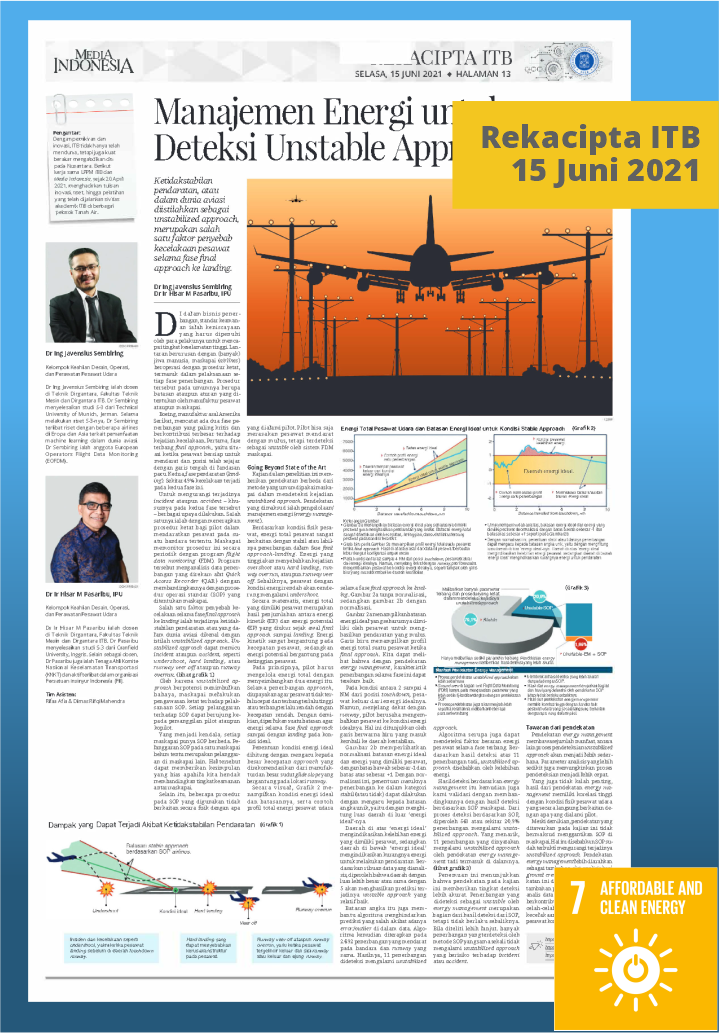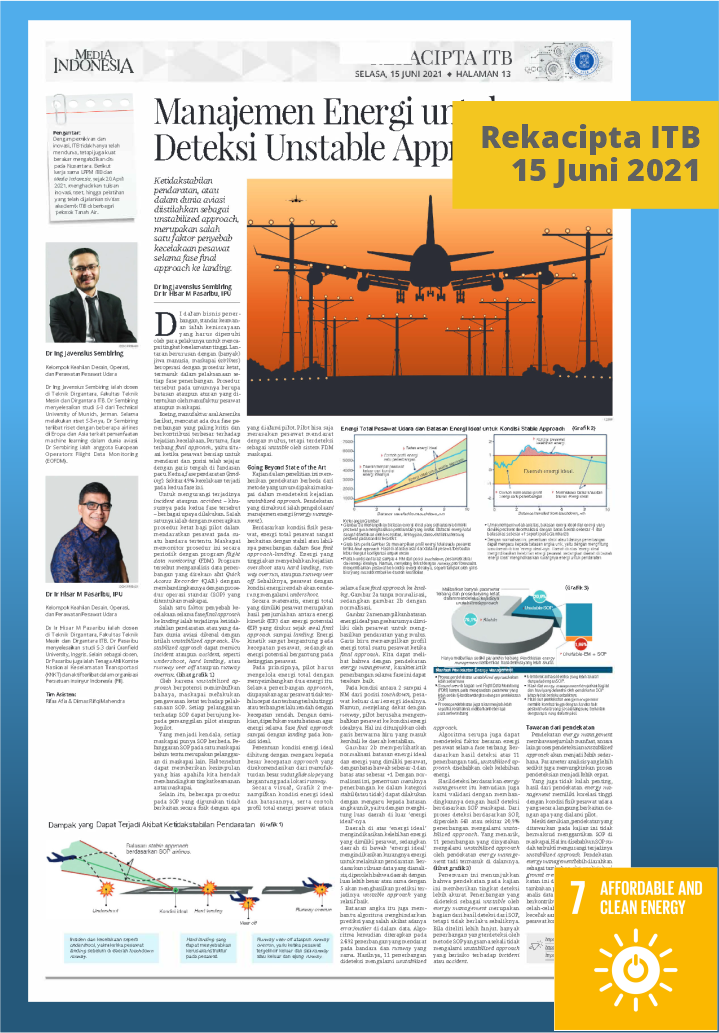

Energy Management for Detection of Unstable Approach
Tags: ITB SDGs , Affordable and Clean Energy , Energy Efficiency , Clean Energy Technology
In the aviation business, safety standards are a necessity that must be met by the perpetrators to achieve a high level of safety. Due to dealing with (many) human souls, airlines (airlines) operate with strict procedures, including in the implementation of every phase of the flight. These procedures are generally in the form of limits or rules set by the aircraft manufacturer or airline.
Boeing, a manufacturer from the United States, noted that there were two phases of flight that were the most critical and contributed the most to accidents. First, the final approach flight phase, which is a situation when the aircraft is preparing to land and the position is parallel to the center line on the runway. Second, the landing phase. Approximately 49% of accidents occur in these two phases.
To reduce the incidence of incidents or accidents, especially in the two phases, various efforts were made. One of them is to implement strict procedures for pilots in landing planes at a certain airport. Airlines monitor this procedure periodically with a flight data monitoring (FDM) program. The program analyzes flight data recorded by the Quick Access Recorder (QAR) by comparing it with standard operating procedures (SOPs) determined by the airline.
One of the factors causing accidents during the final approach to landing phase is the occurrence of landing instability or what in the aviation world is known as the unstabilized approach. Unstabilized approaches can trigger incidents or accidents, such as undershoots, hard landings, or runway veer offs or runway overruns.
Because the unstabilized approach has the potential to cause danger, airlines carry out strict supervision of the implementation of SOPs. Any violation of the SOP can lead to the summons of the pilot or co-pilot.
The problem is that each airline has a different SOP. Violation of SOP on one airline is not necessarily a violation on another airline. This can give biased conclusions if we want to compare security levels between airlines.
In addition, some procedures in the SOP used are not physically related to what the pilot experienced. The pilot may sense the plane is landing smoothly, but is detected as unstable by the airline's FDM system.
Going Beyond State of the Art
The study in this study provides a different approach from the methods commonly used by airlines in detecting the occurrence of the unstablized approach. The approach in question is energy management.
Based on the physical condition of the aircraft, the total energy of the aircraft is closely related to the stable or unstable flight in the final approach-landing phase. High energy will cause overshoot or hard landing, run way overrun, or runway veer off. On the other hand, aircraft with low energy conditions will tend to undershoot.
Mathematically, the total energy possessed by the aircraft is the sum of the kinetic energy (EK) and potential energy (EP) measured from the beginning of the final approach to landing. Kinetic energy is highly dependent on the speed of the aircraft, while potential energy depends on the altitude of the aircraft.
In principle, the pilot must manage the total energy by balancing the two energies. During the approach flight, efforts are made to ensure that the aircraft does not fly too fast and fly too high or fly too low at low speed. Thus, we need a limit so that the energy during the final approach phase until the landing is in ideal conditions.
Determination of ideal energy conditions is calculated by referring to the recommended approach speed of the manufacturer of the glide slope angle depending on the location of the runway.
Visually, Graph 2 shows the ideal energy conditions and their limitations, as well as an example of the total energy profile of the aircraft during the final approach to landing phase. Figure 2a without normalization, while Figure 2b with normalization.
Figure 2a shows the ideal energy limit that an aircraft should have to produce a smooth landing. The blue line shows the total energy profile of the aircraft sound on final approach. We can see that with the energy management approach, the flight characteristics during this phase can be recorded well.
At conditions between 2 to 4 NM from the touchdown position, the aircraft is out of ideal energy. However, close to the runway, the pilot tried to return the aircraft to its ideal energy state. This is indicated by the blue line that reenters the stability zone.
Figure 2b shows the normalization of the ideal energy limit and the energy of the aircraft, with a lower limit of -1 and an upper limit of +1. With this normalization, it is possible to determine whether the flight is classified as stable (or not) by referring to a unique number limit, namely by calculating the area outside its 'ideal energy'.
Areas above 'ideal energy' indicate excess energy the aircraft has, while areas below 'ideal energy' indicate lack of energy to make a landing. Based on thousands of data analyzed, it is found that an area with an area greater than or equal to 5 will produce a relatively good prediction of the occurrence of an unstable approach.
This number limit also helps the algorithm avoid wrong predictions due to errors/outliers in the data. The algorithm was then applied to 2,692 flights that landed at the same airport and runway. As a result, 11 flights were detected having an unstabilized approach
A similar algorithm can also detect the energy factor of the aircraft during the flight phase. Based on the results of the detection of the 11 flights, the unstabilized approach was caused by excess energy.
We then validated the detection results based on energy management by comparing them with the detection results based on airline SOPs. From the detection process based on the SOP, 563 or about 20.9% flights experienced an unstabilized approach. Interestingly, the 11 flights that were declared to have experienced an unstabilized approach by the energy management approach were included in it.
This discovery shows that the approach to this study provides a more accurate level of detection. Flights detected as unstable by energy management is part of the detection results of the SOP, but it does not apply the opposite. When further investigated, many flights detected by the SOP method are not at all experience unstabilized approach which is at risk of incident or accident .
The offer of approach
The energy management approach brings a number of benefits, including the detection process for the unstabilized approach will be simpler. Fewer analytical parameters also allow the detection process to be faster.
No less important, the results of the energy management approach have a high correlation with the physical condition of the aircraft which is directly related to what the pilot experienced
However, the approach offered at this study did not intend to replace the SOP in the airline. This is because SOPs have been proven to reduce the occurrence of an unstabilized approach. Approach Energy Management is more directed at an additional analytical tool for ground crew . At the same time, this approach is expected to provide other perspectives for flight data analysts, while contributing to the improvement of the gaps causing accidents in commercial aircraft aviation. (M-2)

